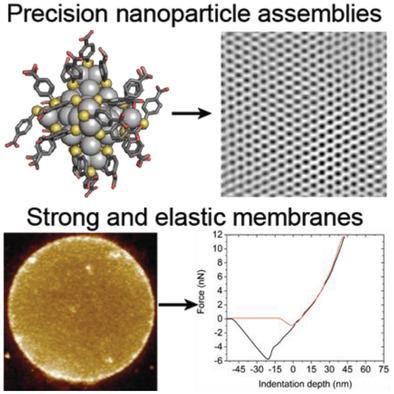Our official English website, www.x-mol.net, welcomes your
feedback! (Note: you will need to create a separate account there.)
Strong and Elastic Membranes via Hydrogen Bonding Directed Self-Assembly of Atomically Precise Nanoclusters
Small ( IF 13.0 ) Pub Date : 2022-08-01 , DOI: 10.1002/smll.202201707 Anirban Som 1 , Alessandra Griffo 2, 3, 4 , Indranath Chakraborty 5, 6 , Hendrik Hähl 3 , Biswajit Mondal 5 , Amrita Chakraborty 5 , Karin Jacobs 3, 4 , Päivi Laaksonen 2 , Olli Ikkala 1, 2 , Thalappil Pradeep 5 , Nonappa 1, 7
Small ( IF 13.0 ) Pub Date : 2022-08-01 , DOI: 10.1002/smll.202201707 Anirban Som 1 , Alessandra Griffo 2, 3, 4 , Indranath Chakraborty 5, 6 , Hendrik Hähl 3 , Biswajit Mondal 5 , Amrita Chakraborty 5 , Karin Jacobs 3, 4 , Päivi Laaksonen 2 , Olli Ikkala 1, 2 , Thalappil Pradeep 5 , Nonappa 1, 7
Affiliation

|
2D nanomaterials have provided an extraordinary palette of mechanical, electrical, optical, and catalytic properties. Ultrathin 2D nanomaterials are classically produced via exfoliation, delamination, deposition, or advanced synthesis methods using a handful of starting materials. Thus, there is a need to explore more generic avenues to expand the feasibility to the next generation 2D materials beyond atomic and molecular-level covalent networks. In this context, self-assembly of atomically precise noble nanoclusters can, in principle, suggest modular approaches for new generation 2D materials, provided that the ligand engineering allows symmetry breaking and directional internanoparticle interactions. Here the self-assembly of silver nanoclusters (NCs) capped with p-mercaptobenzoic acid ligands (Na4Ag44-pMBA30) into large-area freestanding membranes by trapping the NCs in a transient solvent layer at air–solvent interfaces is demonstrated. The patchy distribution of ligand bundles facilitates symmetry breaking and preferential intralayer hydrogen bondings resulting in strong and elastic membranes. The membranes with Young's modulus of 14.5 ± 0.2 GPa can readily be transferred to different substrates. The assemblies allow detection of Raman active antibiotic molecules with high reproducibility without any need for substrate pretreatment.
中文翻译:

通过氢键定向自组装原子级精确纳米团簇的强弹性膜
二维纳米材料提供了非凡的机械、电学、光学和催化性能。超薄二维纳米材料通常通过剥离、分层、沉积或使用少量起始材料的高级合成方法生产。因此,有必要探索更通用的途径,将可行性扩展到原子和分子水平共价网络之外的下一代二维材料。在这种情况下,如果配体工程允许对称破坏和定向的纳米粒子间相互作用,原子级精确的贵纳米团簇的自组装原则上可以为新一代二维材料提供模块化方法。这里用对巯基苯甲酸配体(Na4 Ag 44 - p MBA 30 ) 通过将 NC 捕获在空气-溶剂界面处的瞬态溶剂层中,将其转化为大面积的独立膜。配体束的不规则分布有利于对称性破坏和优先的层内氢键,从而产生坚固而有弹性的膜。杨氏模量为 14.5 ± 0.2 GPa 的膜可以很容易地转移到不同的基材上。该组件允许以高重现性检测拉曼活性抗生素分子,而无需任何底物预处理。
更新日期:2022-08-01
中文翻译:

通过氢键定向自组装原子级精确纳米团簇的强弹性膜
二维纳米材料提供了非凡的机械、电学、光学和催化性能。超薄二维纳米材料通常通过剥离、分层、沉积或使用少量起始材料的高级合成方法生产。因此,有必要探索更通用的途径,将可行性扩展到原子和分子水平共价网络之外的下一代二维材料。在这种情况下,如果配体工程允许对称破坏和定向的纳米粒子间相互作用,原子级精确的贵纳米团簇的自组装原则上可以为新一代二维材料提供模块化方法。这里用对巯基苯甲酸配体(Na4 Ag 44 - p MBA 30 ) 通过将 NC 捕获在空气-溶剂界面处的瞬态溶剂层中,将其转化为大面积的独立膜。配体束的不规则分布有利于对称性破坏和优先的层内氢键,从而产生坚固而有弹性的膜。杨氏模量为 14.5 ± 0.2 GPa 的膜可以很容易地转移到不同的基材上。该组件允许以高重现性检测拉曼活性抗生素分子,而无需任何底物预处理。











































 京公网安备 11010802027423号
京公网安备 11010802027423号